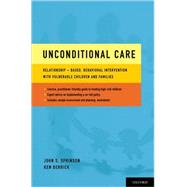
Note: Supplemental materials are not guaranteed with Rental or Used book purchases.
Purchase Benefits
Looking to rent a book? Rent Unconditional Care Relationship-Based, Behavioral Intervention with Vulnerable Children and Families [ISBN: 9780199733033] for the semester, quarter, and short term or search our site for other textbooks by Sprinson, John S.; Berrick, Ken. Renting a textbook can save you up to 90% from the cost of buying.
| Introduction | p. xv |
| Relationship and Engagement as Treatment | p. 1 |
| Opportunities for Engagement | p. 4 |
| Strengths and Risk Factors of Children with Intensive Needs | p. 9 |
| Risk Factors and Vulnerabilities | p. 9 |
| Strengths, Protective Factors, and Exceptions | p. 25 |
| A Final Note on Assessment, Treatment Planning, and Intervention | p. 27 |
| Attachment | p. 28 |
| Some Examples of Relationship in Practice | p. 28 |
| Commonalities of the Case Examples | p. 30 |
| Attachment Principles of Assessment and Intervention | p. 31 |
| Relationship, Attachment, and the Development of Psychopathology | p. 47 |
| From Attachment Theory to "Relationship-Based Intervention" | p. 56 |
| Assessment, Diagnosis, and Case Formulation | p. 63 |
| History of the Child and the Parents' Attachments | p. 68 |
| Current Relationships as They Emerge in Program | p. 68 |
| Traumatic Events | p. 70 |
| Strengths of the Child and the Family | p. 70 |
| Adaptive Capacities | p. 71 |
| Other Observational Categories | p. 73 |
| Relational Assessment and Intervention | p. 77 |
| Underlying Assumptions in Two Diagnostic Models | p. 78 |
| Assessment and Description of the Internal Working Model | p. 81 |
| The Child's Experience with Caretakers | p. 85 |
| The Child's Current Interpersonal Behavior | p. 97 |
| Relational Intervention: Using the Description of the Child's Internal Working Model to Drive Treatment | p. 107 |
| Positive Behavioral Intervention | p. 113 |
| Behavioral Intervention and Relationship-Based Work | p. 114 |
| Why Do Behavioral Intervention? | p. 116 |
| Methods of Behavioral Intervention | p. 119 |
| The Behavior Itself | p. 120 |
| Useful Dimensions for Describing Behavior | p. 122 |
| Criteria for Evaluating Descriptions | p. 124 |
| Behavioral Assessment I: How Much of the Behavior Is Happening? Does It Meet a Defined Standard? | p. 126 |
| Behavioral Assessment II: Attempting to Discern the Function of Behavior | p. 128 |
| The Questions that Drive a Functional Analysis | p. 130 |
| Key Ingredients in Implementing Positive Behavioral Change | p. 136 |
| General Considerations on the Use of Negative Consequences | p. 151 |
| Phases of Treatment and Key Activities | p. 153 |
| Preintake and Initial Screening | p. 154 |
| Assessment | p. 155 |
| Behavioral Intervention | p. 163 |
| Relational Assessment and Treatment | p. 169 |
| The Treatment Process Flowchart | p. 173 |
| Case Illustrations of the Model | p. 176 |
| The Case of David S. | p. 176 |
| The Case of Sarah P. | p. 202 |
| Afterword | |
| A Note Regarding Values | p. 229 |
| Love and Compassion | p. 230 |
| Respect | p. 231 |
| Curiosity | p. 231 |
| Hope and Courage | p. 232 |
| Joy | p. 232 |
| Appendices | p. 235 |
| Relational Assessment Worksheet | p. 235 |
| Relational Treatment Plan | p. 239 |
| Target Behavior Definition Form | p. 240 |
| Behavioral Assessment Planning Worksheet | p. 243 |
| Observation Form-Frequency | p. 247 |
| Observation Form-Intensity | p. 248 |
| Observation Form-Frequency/Duration | p. 248 |
| Observation Form-Duration | p. 249 |
| Functional Assessment Worksheet | p. 250 |
| Client Variables Form | p. 255 |
| Functional Behavior Assessment Form | p. 257 |
| ABC Observation Form | p. 257 |
| Behavior Log | p. 258 |
| Replacement Behavior Worksheet | p. 259 |
| Behavioral Treatment Plan Worksheet | p. 261 |
| Notes | p. 265 |
| References | p. 267 |
| Index | p. 275 |
| Table of Contents provided by Ingram. All Rights Reserved. |
The New copy of this book will include any supplemental materials advertised. Please check the title of the book to determine if it should include any access cards, study guides, lab manuals, CDs, etc.
The Used, Rental and eBook copies of this book are not guaranteed to include any supplemental materials. Typically, only the book itself is included. This is true even if the title states it includes any access cards, study guides, lab manuals, CDs, etc.